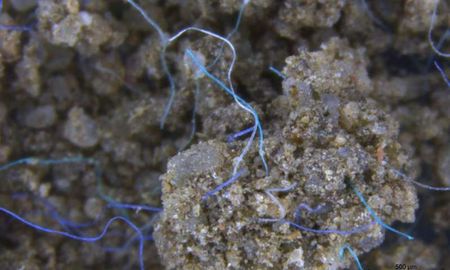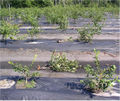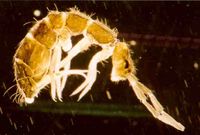Microplastics: Difference between revisions
m The LinkTitles extension automatically added links to existing pages (<a rel="nofollow" class="external free" href="https://github.com/bovender/LinkTitles">https://github.com/bovender/LinkTitles</a>). |
m The LinkTitles extension automatically added links to existing pages (<a rel="nofollow" class="external free" href="https://github.com/bovender/LinkTitles">https://github.com/bovender/LinkTitles</a>). |
||
| Line 22: | Line 22: | ||
==Potential Impacts on Plant and Soil Health== | ==Potential Impacts on Plant and Soil Health== | ||
[[File:Isotoma Habitus.jpg|left|200px|thumb|A [[springtail]], whose movement and ability to escape predations may be debilitated due to microplastic interference with the furcula appendage.]] | [[File:Isotoma Habitus.jpg|left|200px|thumb|A [[springtail]], whose movement and ability to escape predations may be debilitated due to microplastic interference with the furcula appendage.]] | ||
The vast potential consequences of microplastics on soil and plant [[ecology]] in generally unknown [2]. In a study conducted over five weeks, soil was exposed to a concentration of up to 2% of micro-fibrous plastics. Bulk density, water holding capacity, hydraulic conductivity, soil aggregation, and microbial activity were all measured. It was concluded that microplastics effected the bulk density of soil, water holding capacity, and the relationship between microbes and soil. The study suggests that microplastics could potentially be interfering with [[Arbuscular Mycorrhizal Fungi]], a crucial symbiotic relationship many plants rely on. In another study, it was found that microplastics actually inhibit the movement of [[springtail]], an organism that plays a part in soil ecology [8]. There is a clear and surprising knowledge gap on the effects on microplastics on soils and more research is needed in order get a better understanding of the problem and the solutions to fix it [1]. | The vast potential consequences of microplastics on soil and plant [[ecology]] in generally unknown [2]. In a study conducted over five weeks, soil was exposed to a concentration of up to 2% of micro-fibrous plastics. Bulk density, water holding capacity, hydraulic conductivity, soil aggregation, and microbial activity were all measured. It was concluded that microplastics effected the bulk density of soil, water holding capacity, and the relationship between microbes and soil. The study suggests that microplastics could potentially be interfering with [[Arbuscular Mycorrhizal Fungi]], a crucial symbiotic relationship many plants rely on. In another study, it was found that microplastics actually inhibit the movement of [[springtail]], an organism that plays a part in [[Soil Ecology|soil ecology]] [8]. There is a clear and surprising knowledge gap on the effects on microplastics on soils and more research is needed in order get a better understanding of the problem and the solutions to fix it [1]. | ||
Revision as of 12:07, 29 April 2021
Overview
Most commonly studied for the detrimental effects caused in marine environments, the impact of Microplastics on soil ecosystems have been largely neglected. The main sources of microplastic pollution in soil is thought to be plastic mulching film and fertilizer produced through waste water irrigation [1].

Plastic Mulching

Plastic mulch is used to conserve water and subdue weed growth in agriculture. Conventional plastic polymers are typically used as biodegradable alternatives are usually much more expensive [3]. Plastic polymers tend to accumulate in soil as it is broken down due to lack of economical and legal incentive surrounding removal of plastic mulching [1].
Buildup of Microplastics Due to Fertilizer Application

Wastewater facilities receive a large amount of microplastic fibers emitted from industry, surface run-off, and households in urban areas. A surprisingly large amount may come through use of washer machines [4]. Most of these fibers accumulate in sewage sludge, which is often turned into a fertilizer. While there are regulatory methods on the possible pollutants in waste water sludge, there remains none regarding the accumulation of microplastics. Microplastics are able to accumulate in soil through the repeat application of this sewage sludge fertilizer[2].
Unknown Consequences
Studies done in Norway suggest a large portion of microplastics generated in western societies end up in the sludge found at wastewater treatment facilities [1]. In America and Europe, it is estimated that about half of total sewage sludge accumulated each year is used as fertilizer. Estimates range anywhere from 110,000 tons and 730,000 tons of microplastics being transferred to American and European soil each year [5]. There is an estimated total of 93,000 to 236,000 metric tons of microplastic entering the ocean each year [6], making soil potentially a larger reservoir than the ocean for microplastics.
Potential Impacts on Plant and Soil Health

The vast potential consequences of microplastics on soil and plant ecology in generally unknown [2]. In a study conducted over five weeks, soil was exposed to a concentration of up to 2% of micro-fibrous plastics. Bulk density, water holding capacity, hydraulic conductivity, soil aggregation, and microbial activity were all measured. It was concluded that microplastics effected the bulk density of soil, water holding capacity, and the relationship between microbes and soil. The study suggests that microplastics could potentially be interfering with Arbuscular Mycorrhizal Fungi, a crucial symbiotic relationship many plants rely on. In another study, it was found that microplastics actually inhibit the movement of springtail, an organism that plays a part in soil ecology [8]. There is a clear and surprising knowledge gap on the effects on microplastics on soils and more research is needed in order get a better understanding of the problem and the solutions to fix it [1].
Refrences
[1] Lei.(2018).Microplastics in soils: Analytical methods, pollution characteristics and ecological risks.TrAC Trends in Analytical Chemistry.163-172.0165-9936.https://doi.org/10.1016/j.trac.2018.10.006.
[2] Rillig,M.C.(2012).Microplastic in Terrestrial Ecosystems and the Soil?.Environ.Sci.Technol. 46 (12), 6453– 6454, DOI: 10.1021/es302011r
[3] Nizzetto et al (2016): “A theoretical assessment of microplastic transport in river catchments and their retention by soils and river sediments” in Environ. Sci.: Processes Impacts, 2016, 18, 1050-1059. DOI: 10.1039/C6EM00206D
[4] Nizzetto, Futter, Langaas (2016): “Are Agricultural Soils Dumps for Microplastics of Urban Origin?“ in Environ. Sci. Technol. DOI: 10.1021/acs.est.6b04140
[5] Rodríguez-Seijo, Andrés & Pereira, Ruth. (2019). Chapter 3. Microplastics in Agricultural Soils: Are They a Real Environmental Hazard?. 10.1201/9781315205137.
[6] Luís Carlos de Sá, Miguel Oliveira, Francisca Ribeiro, Thiago Lopes Rocha, Martyn Norman Futter.(2018).studies of the effects of microplastics on aquatic organisms: What do we know and where should we focus our efforts in the future?.Science of The Total Environment.Volume.645.1029-1039.0048-9697.https://doi.org/10.1016/j.scitotenv.2018.07.207
[7] Anderson Abel de Souza Machado, Chung Wai Lau, Jennifer Till, Werner Kloas, Anika Lehmann, Roland Becker, and Matthias C. Rillig Environmental Science & Technology 2018 52 (17), 9656-9665 DOI: 10.1021/acs.est.8b02212
[8]Kim, S. W., and Y.-J. An. 2019. Soil microplastics inhibit the movement of springtail species. Environment International 126:699–706.